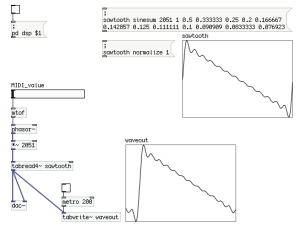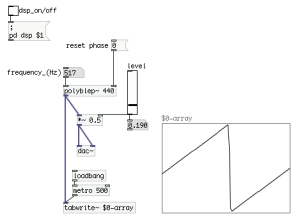I have recently gotten back into Pure Data in the interest of familiarizing myself more with it, and perhaps to integrate it with Unity for a future project. For anyone who may not be familiar with it, more info on it can be found here. It’s a great environment for building synthesizers and experiment with a great variety of audio processing techniques in a modular, graphically-based way.
Oscillators are the foundation of synthesizers of course, and Pure Data comes with two modules that serve this purpose: osc~ for sine waves, and phasor~ for a sawtooth (it’s actually just a rectified ramp in the range 0 – 1, so it needs a couple of minor additions to turn it into a sawtooth wave). However, the phasor~ module (not being band-limited) suffers from aliasing noise. This can be avoided either by passing it through an anti-aliasing filter, or by using the sinesum message to construct a sawtooth wave according to the Fourier Theorem of summing together sine waves (i.e. creating a wavetable). Both of these methods have some drawbacks though.

Constructing a sawtooth from a wavetable of 12 harmonics (source: http://en.flossmanuals.net/pure-data/).
A robust anti-aliasing filter is often computationally expensive, whereas wavetables sacrifice the quality of the waveform and are not truly band-limited across its entire range (unless the wavetable is divided into sections constructed with decreasing number of harmonics as the frequency increases). A wavetable sawtooth typically lacks richness and depth due to the lack of harmonics in its lower range. These issues can be fixed by constructing the sawtooth using band-limited steps (BLEPs), which are based on band-limited impulse trains (BLITs), at the expense of some increased complexity in the algorithm. And fortunately, Pure Data allows for custom modules to be built, written in C, that can then be used in any patches just like a normal module.
The process behind this method is to construct a naive sawtooth wave using the equation
sample = (2 * (f / SR * t)) – 1
where f is frequency (Hz), SR is sample rate (Hz), and t is a time constant (in this case, the sample count). At the waveform’s discontinuities, we insert a PolyBLEP to round the sharp corners, which is calculated by a low order polynomial equation (hence, “Poly”nomial Band-Limited Step). The polynomial equation is of the form
x2 + 2x + 1
The equation for the PolyBLEP is based on the discussion of the topic on this KVR forum thread. The concensus in the thread is that the PolyBLEP is far superior to using wavetables, but sounds slightly duller than using minBLEPs (which are far more complicated still, and require precalculation of the BLEP using FFT before integrating with the naive waveform). PolyBLEP oscillators strike a good balance between high quality, minimal aliasing noise, and reasonable complexity.
Here is a quick sample of the PolyBLEP sawtooth recorded from Pure Data. Of course, PolyBLEPs can be used with other waveforms as well, including triangle and square waves, but the sawtooth is a popular choice for synths due to it’s rich sound.
The GitHub page can be found here, with projects for Mac (Xcode 5) and Windows (Visual Studio 2010).

